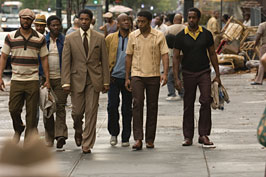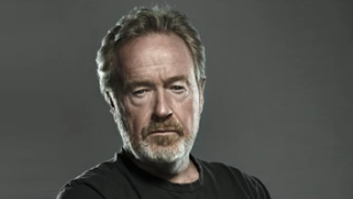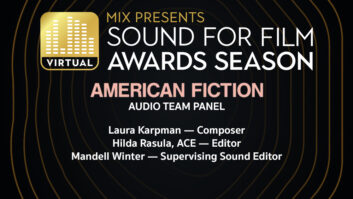
Since he made his first splash as a feature film director with The Duelists 30 years ago, Ridley Scott has established himself as one of our most compelling and stylish storytellers. He is rightly revered for his ability to immerse the viewer in whatever world he creates, whether it’s the gritty, futuristic L.A. of Blade Runner, the gory spectacle of ancient Rome in Gladiator, the frenetic blur of modern war in Black Hawk Down, the sprawling vistas of the Middle East during The Crusades in Kingdom of Heaven or even the bucolic tranquility of Provence in A Good Year.
In Scott’s latest, American Gangster, he takes us to yet another time and place, which he re-creates with his inimitable flair and attention to detail: the mob-controlled drug underworld of Harlem in the early 1970s. The film tells the true story of a heroin kingpin named Frank Lucas (played by Denzel Washington), who manages to outmaneuver the Mafia on his way to dominating the drug trade in northern Manhattan, but then must deal with an even tougher adversary — an anti-narcotics task force led by a tenacious detective named Richie Roberts (Russell Crowe, a veteran of several Scott films). The multitextured story tackles a number of themes, including the violence of competing organized crime groups, police corruption, city politics, even the raging war in Vietnam — Lucas initially smuggles heroin into the U.S. with the bodies of American servicemen killed in the war.
Scott’s films always have an interesting soundtrack — that’s why they have earned a slew of Academy Award, BAFTA, C.A.S. and Golden Reel nominations and trophies for sound dating all the way back to Black Rain in 1989. Two of the re-recording mixers who won Oscars (separately) on Scott’s films — Bob Beemer (Gladiator) and Mike Minkler (Black Hawk Down) — worked together on American Gangster, and as has been the case on most of the director’s films in recent years, Per Hallberg and Karen Baker Landers co-supervised the show. The post was done at Todd-AO West, which is based around a Euphonix System 5 console and a plethora of Pro Tools systems.
“When we start a film with Ridley,” Hallberg says, “he usually doesn’t explain very much. What we do is look at the film and we talk about the picture, and since we’ve done quite a few films with him we know the kinds of things he likes and what he’s looking for. But as for specific notes, he’s not so big on that. One of the main things for this film — and this was the only note, really — was to make you feel like you’re really in the city and the city’s pressure is on you all the time. He shot this film purposefully in the right locations — mostly in the middle of Harlem — and most of them were very noisy, so there were a lot on the production tracks to fight with. But that’s how he wanted it. He wanted it to look like it was in the right place and he wanted it to sound like it was in the right place.”
“Right from the get-go, from talking to Per and coming from Pietro Scalia, the picture editor, we knew that [the sound] was always going to be noisy and aggressive,” notes Minkler. “That was dictated by the fact that Ridley on location was kind of shooting from the hip — they were always moving, moving, moving, changing locations: It’s on the streets, it’s in the warehouse, it’s back on the streets, it’s in a car, they’re driving. It was written that way and it’s paced that way. It’s a very extensive story with a lot of locations. He wanted this energy, and I gather that sometimes they were moving so quickly that they didn’t have time to rehearse the sounds or block off the streets. So the noise level of New York City is quite apparent. And Ridley wanted to maintain that: ‘It’s madness out there.’ The production tracks [recorded by William Sarokin] are very rich and full of noise.”

Sound supervisors Per Hallberg and Karen Baker Landers.
“But appropriately,” adds Beemer (who shared an Oscar with Minkler last year for Dreamgirls). “It’s really like the grander character in this film is Harlem, so Ridley wanted to capture the city noise you hear pretty much wherever you go. Ridley was really impressed by how loud the El trains were. He kept remarking, ‘I don’t know how people can live there because it’s so bloody loud.’ He was interested in maintaining that constant din. So there’s lots of different textures — trains and sirens and trucks and people playing music, and people arguing and laughing and all that. It’s a very full track.”
“Ridley is not afraid of sound,” Baker Landers adds. “He loves sound effects and he loves to feel things in a film. And you really do in his films. One of the most impressive elements of American Gangster, from a sound perspective, is the backgrounds. They’re so full and rich and there’s stuff going on everywhere. You really do feel like you’re there.” (In addition to the New York locations, there are also scenes in the opium fields of Thailand, “where we hear lots of bugs,” Minkler notes with a chuckle.)
I wondered if having a busier production track limited the flexibility of the post team when it came to creating backgrounds and spotting effects. “Absolutely,” Hallberg replies. “That was the biggest challenge — to get that track down and still be able to hear the dialog so that we could then add all the other things. Almost every location in the movie has new stuff going on and there’s always something happening. Ridley doesn’t shoot anything one-dimensional. He likes scenes that are deep, with lots of activity back in the shot. That’s one reason his movies are so interesting to look at. Well, he wants there to be three dimensions to the sound, too. You have to have the dialog and all the stuff behind it to sell the illusion of reality and put you right there. Mike [Minkler] and our dialog editors worked really hard to clean out as much noise as possible [from the production track] without losing the richness.”
“We had layers and layers of specific car-bys, fire truck-bys, trains, horns and sirens,” Beemer says, but we were able to specifically place them in different speakers to try not to intrude on the dialog but to keep that aggressive presentation at all times.
“Another challenge was dealing with the transitions and making the backgrounds and environments sound distinct and aggressive and interesting, and yet somehow not make the dialog difficult to hear,” he continues. “Or maybe at times it is difficult to hear, but it’s intentional. So keeping it alive and aggressive, but in its proper place — and in every situation, its proper place is a little different.”
What does “aggressive” mean when it comes to mixing? “It means letting her rip,” Minkler says. “A lot of mixers take the approach of making things elegant and smooth; it’s a tendency that you lean toward. But when they say, ‘No, we’re going aggressive,’ you completely change your style and you do things in a more flamboyant way to the point where you might actually be overdoing it. It can be loud, it can be soft, it can be sudden, it can be overlapping. — whatever it is that makes it jump more.”
Although he rarely gets involved with the details of the sound job as it’s going down, Scott encouraged the supervisors and mixers to heighten the sonic drama at almost every turn. “He really gives you the opportunity to stretch yourself,” Baker Landers says of the director. “You can stretch yourself as far as you can imagine, and generally he’ll embrace it.”

Re-recording mixers Mike Minkler (left) and Bob Beemer
“Not only that,” adds Hallberg, “but when you think you’ve done something as extreme as you dare to, he will say, ‘That’s not quite enough.’ And we’ll say — even Mike in the mixing room — ‘We can’t do it!’ And he’ll just smile, and say, ‘Yes, you can.’ He’ll push you a couple of steps more than you think is possible.”
“He usually doesn’t get that involved with specifics,” says Beemer. “He takes the grand approach. He hires the people he wants, almost like casting, and then he gives you a broad impression, which is very accurate but he doesn’t micromanage how you accomplish it. If you don’t do it right, he’ll tell you and we’ll fix it. But he doesn’t get that deep into it. He’s like an artistic octopus dealing with all these levels at the same time. It’s really impressive to watch.”
Picture editor Pietro Scalia is also intimately involved in the process of putting together the soundtrack; indeed, his editing helps dictate the flow of the film, and its rhythm suggests a certain sound approach. “He works in the Avid pretty well with the sound effects that Per provides him with,” Minkler comments. “As he’s cutting, he’s always talking to Per: ‘Give me some of this and some of that.’ He likes to have fun with it. We don’t usually use his stuff, because once it goes in the Avid and comes back out it’s pretty mangled. We get the same sound effects and we might use [Scalia’s] automation file, but it’s a fresh recording, and, of course, we’re doing other things with it, too.”
“In this case,” Hallberg notes, “Pietro also got music very early on from Marc Streitenfeld, the composer. Even in our first temp dub, we had a lot of the score from Mark — that was fairly unusual. Working that way suits everyone really well. They got him very early on — he was writing music when they were still shooting, and Pietro had Marc’s temp score in his Avid so they could make sure it hit the right spots and was the right feeling.” A protégé of Hans Zimmer, Streitenfeld worked as a music editor on Scott films dating back to Gladiator (which was scored by Zimmer), but got his first shot at composing for the director on A Good Year.
“It’s a very dense, complex, unconventional musical score and we really had our hands full trying to fit it in with the thickness of the production track and the sound effects and all that,” Minkler says. “But it’s almost never intended to be just sitting there playing and articulating like so many big scores do. It almost takes a back seat in a lot of places and becomes an underlying mood. There’s a lot of score, but sometimes you don’t notice it so much and it’s still very effective. It’s not being underplayed, it’s just being subordinate. It’s not, ‘Here’s a piece of music!’”
“There’s also a lot of really cool source music,” Beemer notes. “What’s that song, ‘[Across] 110th Street?’ It’s a classic R&B song from the ’70s [by Bobby Womack]. The film occasionally goes into a montage, and that one’s particularly great because it’s about the drug dealing and distribution network that Denzel’s character has. And the song actually refers to one of the streets that Frank Lucas operates from. It’s a great match because it really puts you in that time. Then when they’re in Frank Lucas’ café that he operates from, there’s source music that puts you in the time.”
When it came to period-specific FX, Hallberg and Baker Landers were meticulous in their search for the right car sounds, some of which they found in the Soundelux library and some of which they recorded new. “There’s a ’65 [Mustang] Fastback that’s like this big old muscle car,” Baker Landers says, “and is important in the film. It was so much fun playing with that car taking off.”

In general, the sound approach to the film was fairly realistic, “but there are also some stylized moments, which you always get in Ridley’s films,” she says. “We always took our cue from what’s up on the screen. We were able to get creative in some montages.”
And then there’s the scene where, Beemer says, “the streets are really busy and Lucas goes to deal with one of his adversaries and he ends up shooting him, so, of course, people are screaming and running everywhere, but on the [sound] track, the din drops almost to zero and then gradually creeps up; it’s very effective. It’s definitely stylized, but it’s done in a kind of natural manner. There’s a suddenness when a gunshot goes off in the middle of a very busy street, but then it’s back to normal within, like, 25 seconds.
“It’s almost like, ‘Oh, well, another murder in Harlem,’” Minkler says with laugh. “It’s like ‘BAM, scream, quiet,’ and then it comes back up. It’s very powerful and it doesn’t feel gimmicky at all.”
“I think what makes this movie so harrowing is its bold reality,” Beemer says. “You really feel frightened. Because it’s not that stylized, it really feels like you’re there.”
“It’s a very handsome movie made by a great director,” Minkler concludes. “The acting is amazing, the writing is great. Everything about it is big and classy. It’s what you’d expect from someone like Ridley Scott.”






